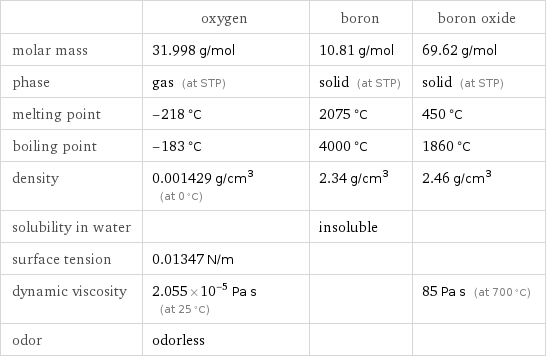Input interpretation

oxygen + boron ⟶ boron oxide
Balanced equation

Balance the chemical equation algebraically: + ⟶ Add stoichiometric coefficients, c_i, to the reactants and products: c_1 + c_2 ⟶ c_3 Set the number of atoms in the reactants equal to the number of atoms in the products for O and B: O: | 2 c_1 = 3 c_3 B: | c_2 = 2 c_3 Since the coefficients are relative quantities and underdetermined, choose a coefficient to set arbitrarily. To keep the coefficients small, the arbitrary value is ordinarily one. For instance, set c_3 = 1 and solve the system of equations for the remaining coefficients: c_1 = 3/2 c_2 = 2 c_3 = 1 Multiply by the least common denominator, 2, to eliminate fractional coefficients: c_1 = 3 c_2 = 4 c_3 = 2 Substitute the coefficients into the chemical reaction to obtain the balanced equation: Answer: | | 3 + 4 ⟶ 2
Structures

+ ⟶
Names

oxygen + boron ⟶ boron oxide
Reaction thermodynamics
Enthalpy

| oxygen | boron | boron oxide molecular enthalpy | 0 kJ/mol | 0 kJ/mol | -1274 kJ/mol total enthalpy | 0 kJ/mol | 0 kJ/mol | -2547 kJ/mol | H_initial = 0 kJ/mol | | H_final = -2547 kJ/mol ΔH_rxn^0 | -2547 kJ/mol - 0 kJ/mol = -2547 kJ/mol (exothermic) | |
Chemical names and formulas

| oxygen | boron | boron oxide Hill formula | O_2 | B | B_2O_3 name | oxygen | boron | boron oxide IUPAC name | molecular oxygen | boron |
Substance properties

| oxygen | boron | boron oxide molar mass | 31.998 g/mol | 10.81 g/mol | 69.62 g/mol phase | gas (at STP) | solid (at STP) | solid (at STP) melting point | -218 °C | 2075 °C | 450 °C boiling point | -183 °C | 4000 °C | 1860 °C density | 0.001429 g/cm^3 (at 0 °C) | 2.34 g/cm^3 | 2.46 g/cm^3 solubility in water | | insoluble | surface tension | 0.01347 N/m | | dynamic viscosity | 2.055×10^-5 Pa s (at 25 °C) | | 85 Pa s (at 700 °C) odor | odorless | |
Units
